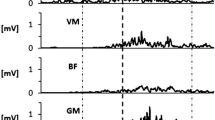Abstract.
The purpose of the present study was to investigate the interaction between the pre-landing activities and the stiffness regulation of the knee joint musculoskeletal system and the takeoff speed during a drop jump (DJ). Nine healthy male subjects performed a DJ test from the height of 50 cm. The surface electromyographic (EMG) activity of the vastus lateralis (VL) muscle was recorded to evaluate both the pre-landing and post-landing muscle activation levels. Simultaneous recording of the jumping motion and ground reaction force was performed by a high-speed video camera (100 frames·s–1), and a force platform was employed to allow joint moment analysis. Joint stiffness was calculated by a linear regression of the knee joint moment/angle relationship. Elasticity of the knee extensor muscle during DJ was estimated by means of a four-element muscle model consisting of a parallel elastic component, a series elastic component (SEC), a viscous damper, and a contractile element. DJ performance correlated positively with the positive peak power of the knee joint (P<0.01) and with the moment of the knee joint at the end of stretch (P<0.01). However, there was no significant relationship between DJ performance and the positive peak power of the ankle joint. The knee joint moment at the end of stretch correlated with the SEC stiffness during the transmission phase from the end of the initial impact to the onset of the concentric action (P<0.01) and with the maximum rate of isometric force development of the knee extensors (P<0.01). Multiple regression analysis showed that the SEC stiffness during the transmission phase of the knee joint can be explained by a combination of the pre-activity of the VL muscle and the knee joint angular velocity at touchdown (F=5.76, P<0.05). These results seem to emphasize the functional significance of the pre-programmed activity for controlling the subsequent stiffness regulation and then contributing to the performance in DJ. Thus, it can be suggested that the centrally pre-programmed activity and the associated elastic behavior of the SEC in the knee extensor muscle in conjunction with the muscle contractile property play a major role in regulating the performance in DJ.
Similar content being viewed by others
Author information
Authors and Affiliations
Additional information
Electronic Publication
Rights and permissions
About this article
Cite this article
Horita, .T., Komi, .P., Nicol, .C. et al. Interaction between pre-landing activities and stiffness regulation of the knee joint musculoskeletal system in the drop jump: implications to performance. Eur J Appl Physiol 88, 76–84 (2002). https://doi.org/10.1007/s00421-002-0673-6
Accepted:
Issue Date:
DOI: https://doi.org/10.1007/s00421-002-0673-6




